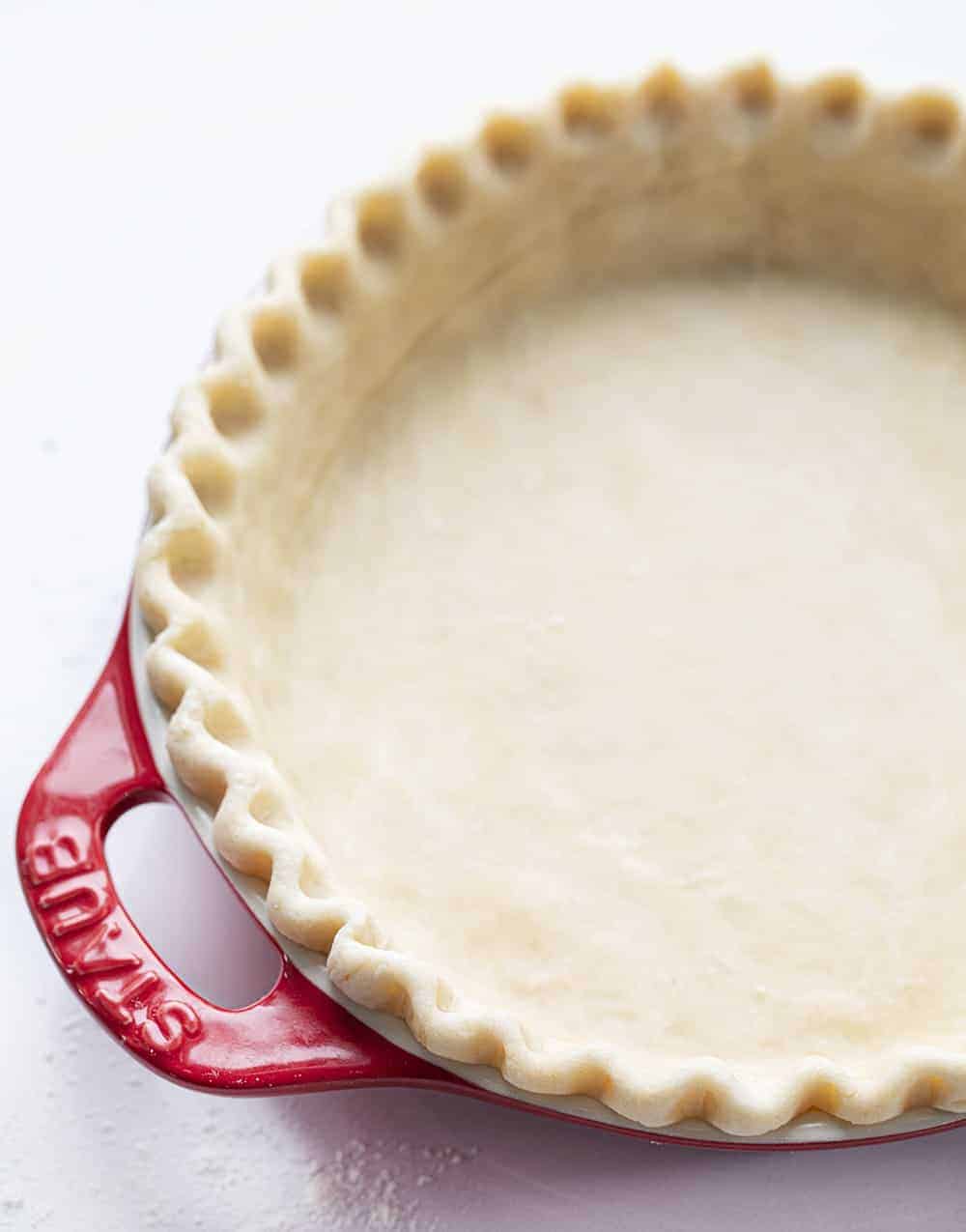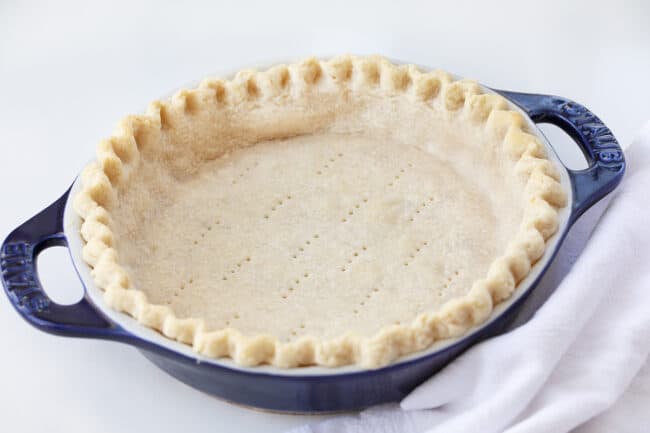Addicting and easy to handle, this Homemade Pie Crust will be your go-to pie crust recipe. Despite how you use it – hot pies, cold pies, or hand pies – you’ll get a delicate flaky holding vessel every time! If you are interested in an ALL BUTTER Pie Crust, I have that recipe here.

Homemade Pie Crust
This homemade pie crust is a no-fail pie crust that is my go-to crust for everything that needs, well, a crust. It is light and flaky and perfect for anything from apple pies to pot pies to Pop Tarts! The recipe is super simple, and I know you can do it!
Now, I know that everyone has their favorite homemade pie recipe. And yes, mine happens to be with shortening.
Can I Substitute Lard?
Yes! Let me explain. Shortening is 100% fat, which helps pie crusts (like this one) and pastries turn out so flaky and crumbly. And because shortening is all fat, it is hard to make substitutions. If you do have to substitute for shortening, your best bet is lard because it is also 100% fat. If using lard in place of shortening, use 2 tablespoons less of lard for every one cup of shortening.
Can I Use Margarine?
So, can you use butter or margarine in place of shortening or lard? It’s not your best bet in this recipe. Butter is 80% fat, which is close but made of water, which may keep the crust from being light and flaky. Margarine has been used to replace shortening because it is also made with vegetable oil, but it can be as low as 35% fat.
Making any substitutions in recipes can have an effect on the final product.
How to Transfer Rolled Dough to the Pan
There are two methods I use often.
- Once your dough is rolled out on the floured surface, you simply roll it onto the rolling pin and then unroll it into your pie plate. Do not stretch the dough to fit the pie pan, it will shrink from the edge if you do. Just let it naturally fall into the pan and press down gently if needed.
- The second method is folding. With cold hands, fold the top half of the dough over the bottom half, creating two layers of dough. Fold this in half again, this time folding the left half over the right. Transfer to pie pan and place in the bottom (right or left side depending on how you folded) and unfold it into the dough.

Hot Pies
For a hot pie, divide the chilled dough in half and set it on a flour work surface. Roll out half of the dough to about 1/4 inch thickness and then transfer it to a 9-inch pie pan.
If the hot pie is covered, roll the second half of the dough to about a 1/4-inch thickness. Bake the pie as instructed in the recipe. Store any remaining dough by wrapping tightly in plastic and refrigerating.

Cold Pies
To use this homemade pie crust for a cold pie, divide the chilled dough in half and set it on a flour work surface. Roll out half of the dough to about 1/4 inch thickness and then transfer it to a 9-inch pie pan. Continue with the instructions of the cold pie recipe you are using.

Docking a Crust vs. Pie Weights
Before baking the crust, be sure to dock it. To dock the crust simply means to poke holes in the crust with a fork. This will help the crust to cook more evenly and prevent any pockets or bubbles from forming in the crust. If you dock the crust, you do not need to weigh the crust down.
If you choose to use pie weights (as opposed to docking), loosely fit aluminum foil over the pie dish and weigh it down with pie weights, raw rice, or uncooked beans before baking according to the recipe. The only time I prefer using pie weights is when the filling is runny, as when baking a quiche.

Freezing and Thawing Pie Crust
To Freeze: You can absolutely freeze this pie dough. Shape the dough into a disc, roughly 6-inches in diameter. Lightly dust both sides with flour and then wrap it tightly with plastic wrap. Then either place it in a freezer-safe bag or wrap it tightly in aluminum foil. Be sure to label and date. It should last 6 months in the freezer.
To Thaw: When you are ready to use the pie crust, place it in the refrigerator for 24 hours or overnight. When you are ready to start the pie filling, remove the dough from the refrigerator for about 15 minutes, or while you are preparing the filling.
Recipes with Homemade Pie Crust

Homemade Pie Crust
Ingredients
- 4 cups (500 g) all-purpose flour
- 1 tablespoon granulated sugar
- 1½ teaspoons kosher salt
- 1½ cups (307.5g) shortening, cubed*
- 1 large egg, beaten
- 1 tablespoon vinegar
- ½ cup (118 g) water
Instructions
- In the bowl of a food processor**, pulse together the flour, sugar, and salt until combined. Add the shortening and pulse until pea-sized crumbs form. Transfer the dough to a large bowl and bring the dough together with a wooden spoon.
- In a small bowl, whisk together the egg, vinegar, and water. Pour over the dough and mix until combined (dough will be sticky). Form the dough into a disc shape and wrap securely with plastic wrap. Chill it in the refrigerator for at least 1 hour before rolling.
Hot Pie
- For a hot pie (e.g. with a filling that needs to be baked), divide the chilled dough in half on a generously floured work surface.
- Roll half of the dough to ¼-inch thick and transfer to a 9-inch pie dish. Repeat with the second half of the dough if the pie is covered.
- Bake as instructed in the recipe. Wrap any remaining dough in plastic wrap and store in the refrigerator.
Cold Pie
- For a cold pie (e.g. with a filling that doesn't need to be baked), divide the chilled dough in half on a generously floured work surface. Roll half of the dough to ¼-inch thick and transfer to a 9-inch pie dish.
- Continue by following the instructions of your cold pie recipe. Wrap any remaining dough in plastic wrap and store in the refrigerator.
Notes
Did you make this recipe?
Thank you for making my recipe! You took pictures, right? Well go ahead and post them on Instagram! Be sure to mention me @iambaker and use the hashtag #YouAreBaker.

















Did not work for me. Was crumbly and fell apart. Had to piece it into pie plate.
Oh no! I’m sorry to hear the crust didn’t turn out as expected. Pie crusts can be tricky, and sometimes they have a mind of their own! Crumbliness can happen if the dough needs a touch more moisture. Next time, try adding ice water one tablespoon at a time until it just starts to hold together—humidity and even flour type can sometimes make a difference. And if the dough is cracking, a quick tip is to let it rest for a few more minutes at room temperature before rolling out. I hope this helps, and don’t hesitate to reach out if you have more questions. Pie crust success is in your future!
I had the same problem with being crumbly. I will try the ice water next time.
This is the same recipe my mom pasted down to us. I have tried others but go back to this recipe. Have never had it fail. I have used personally for at least 50 years
I have trouble with a “wet” filling for piecrust never baking fully without over-baking the pie. Should I pre-bake it for a few minutes to be sure it totally bakes? Thank you for your wonderful recipes and suggestions.
Hi Andrea – Thank you so much for your kind words! ❤️ For pies with a wetter filling, pre-baking (or blind baking) the crust can definitely help ensure it’s fully baked without over-cooking the filling. Here’s how:
Line your crust with parchment paper and fill it with pie weights (or dried beans/rice) to keep it from puffing up.
Bake at 375°F (190°C) for about 10-15 minutes, or until the edges start to turn golden.
Remove the weights and parchment, then bake for another 5-7 minutes to firm up the bottom.
This gives you a sturdy base to work with and helps avoid that dreaded soggy crust! Happy baking, and let me know how it goes!
I have used that pie crust recipe for over sixty years. Never ever had a bad crust.
Me too! My absolute favorite pie crust recipe.
Love this recipie. Reminds me of moms that she used before she passed away. I never got any of her recipes but to find one so close made making the pies for thanksgiving a little easier and I felt closer to her.
Could you substitute cold butter fir the shortening?
Excellent pie crust recipe
Hi Amanda..
I want to make butter tarts using this pastry crust. So with the recipe that you have printed right here, how many tarts would that make because my filling makes about 4 to 5 dozen tarts so I’d like to make the appropriate amount of pastry crust.
Thank you.
Hi there! Great question—and I wish I had a perfect answer for you, but it really depends on the size of your tart shells and how thin you roll the dough.
This recipe makes two standard 9-inch pie crusts, so if you’re making mini tarts (about 2.5–3 inches in diameter), you might get roughly 18–24 shells per full batch, depending on how efficient your cutting is and if you re-roll scraps.
Since your filling makes 4–5 dozen tarts, I’d recommend tripling the crust recipe to be safe—you can always freeze any extra dough for later. Hope they turn out beautifully!
Can I ask you what kind of rolling pin you use. I have never seen a metal one. Will definitely try this recipe, as there are so many comments saying it’s so good. I’m usually a failure with pie crusts. Fingers crossed!